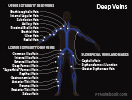Deep Vein Thrombosis of the Upper Extremity, Upper Extremity Deep Venous Thrombosis, Upper Extremity DVT, PICC Line Thrombosis, Brachial Vein Thrombosis, Axillary Vein Thrombosis, Brachiocephalic Vein Thrombosis, Subclavian Vein Thrombosis, Internal Jugular Vein Thrombosis, Radial Vein Thrombosis, Ulnar Vein Thrombosis, UEDVT, Effort Thrombosis, Paget-Schroetter Syndrome
- Epidemiology
- Upper extremity accounts for 5-10% of Deep Vein Thrombosis (DVT)
- Patients tend to be younger and of leaner body habitus than those with lower extremity DVT
- Anatomy
- Deep Veins of Arm
- Proximal Deep Veins
- Subclavian Vein (most common DVT site)
- Axillary Vein (common DVT site)
- Internal Jugular Vein (included in Upper Extremity DVT by some authors)
- Brachiocephalic Vein
- Distal Deep Veins
- Brachial Vein
- Radial Vein
- Ulnar Vein
- Proximal Deep Veins
- Superficial Veins of Arm
- Cephalic Vein
- Basilic Vein
- Causes
- Central Venous Catheter (common)
- PICC Line Thrombosis (complicates 3-5% of PICC Lines)
- Effort Thrombosis (Paget-Schroetter Syndrome)
- Incidence 1 to 2 per 100,000 per year in U.S.
- Venous form of Thoracic Outlet Syndrome
- Musculoskeletal swelling of axilla and upper arm results in external
- Compression interferes with arm venous outflow
- Occurs in athletes with upper extremity Muscle hypertrophy (rowers, swimmers, pitchers, tennis players, weight lifters)
- Overuse with hypertrophy of scalene Muscles, especially in dominant arm
- Increased risk with congenital cervical ribs or subclavius ligaments
- Idiopathic (uncommon)
- Evaluate for occult cancer (up to 40% of Upper Extremity DVT causes)
- More likely than with lower extremity DVT
- Consider evaluation for Hypercoagulable state
- Evaluate for occult cancer (up to 40% of Upper Extremity DVT causes)
- Signs
- Arm with palpable cord
- Supraclavicular fullness
- Cyanosis or bluish discoloration of the extremity
- Serous drainage from PICC Line insertion site
- Venous distention
- Superficial vein distention (esp. chest wall and Shoulder)
- Jugular Venous Distention
- Differential Diagnosis
- Imaging
- Images
- Duplex Ultrasound of upper extremity
- Test Sensitivity and Test Specificity approach 100% with skilled ultrasonagrapher
- Proximal subclavian vein may be difficult to image (clavicle shadowing)
- Advanced imaging options in indeterminate Ultrasound
- CT or MRI (timed for venous phase evaluation)
- Management
- Proximal Upper Extremity Deep Vein Thrombosis
- Indications: Proximal Deep Vein Thrombosis
- Subclavian Vein Thrombosis
- Axillary Vein Thrombosis
- Internal Jugular Vein Thrombosis
- Brachiocephalic Vein Thrombosis
-
Anticoagulation
- See Anticoagulation in Thromboembolism
- Duration: Typically 3 months (6 months or longer may be required if persistent risk)
- Consider catheter directed Thrombolysis (severe acute edema, pain presentations)
- Large thrombus
- Acute within last 2 weeks
- Patients with low bleeding risk
- Management
- Distal Upper Extremity Deep Vein Thrombosis
- Indications: Distal Deep Vein Thrombosis
- Brachial Vein
- Radial Vein
- Ulnar Vein
- Approach
- Observation (typical) OR
- Prophylactic dose Anticoagulation OR
- Therapeutic dose Anticoagulation (high risk patients)
- Catheter-Associated Venous Thrombosis and catheter remaining in place (see below)
- Cancer patients with low risk of bleeding
- Management
- PICC Line Venous Thrombosis
-
PICC Line venous thrombosis risk: 2.5%
- May present as serous drainage from the PICC insertion site
- New Recommendations
- PICC Line does not need to be removed in most Upper Extremity DVTs (if functional and ongoing need)
- Anticoagulate for 3 months regardless of presence of cancer (or as long as PICC in place if longer than 3 months)
- Older recommendations were to remove the PICC Line and not replacing (even if placed on opposite side)
- References
- (2012) Chest 141(2): e419S-e494S [PubMed]
- DeLoughery and Orman in Majoewsky (2012) EM:Rap 12(12): 4-5
- Jones (2010) J Vasc Surg 51(1):108-13 [PubMed]
- Complications
- Pulmonary Embolism (6% of cases; contrast with lower extremity DVT related PE of 33%)
- Post-thrombotic Symdrome (13% of cases)
- Superior Vena Cava Syndrome
- References
- McCollom (2021) EM:Rap 21(8)
- Mintz and Levy (2017) Upper Extremity Deep Vein Thrombosis, ACC Website, accessed 8/6/2021
- Engelberger (2012) Circulation 126(6):768-73 +PMID: 22869858 [PubMed]
- Joffe (2002) Circulation 106:1874-80 [PubMed]
- Simon (2023) Am Fam Physician 107(5): 503-12 [PubMed]
